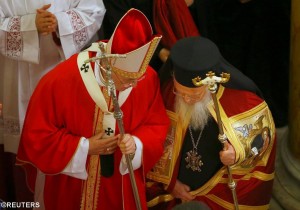Religious life is prophetic
“In the church, the [consecrated] religious are called to be prophets in particular by demonstrating how Jesus lived on this earth, and to proclaim how the kingdom of God will be in its perfection. A religious must never give up prophecy … Let us think about what so many great saints, monks, and religious men and women have done, from St. Anthony the Abbot onward. Being prophets may sometimes imply making waves.” —Pope Francis, La Civilta Cattolica interview, September 2013.
“When there is no prophecy among the people, clericalism fills the void.”
Pope Francis, daily Mass homily, December 16, 2013.
Turkey is precious for Christians, Pope states
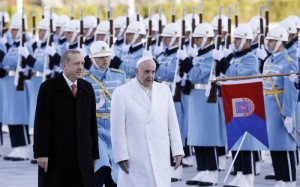 At work is the interface between Christian faith and public order with Pope Francis making a three day visit to Turkey. A new and concrete plan for peace is needed so that, as Francis says, conflict is not merely the daily and accepted way of life. There is nothing dignified about killing the person who thinks and prays differently from us. The Bishop of Rome calls the visit a “dialogue of friendship.” Nonetheless, his trip to this highly Islamic and fanatic country is going to be interesting in terms of relationships of peace, mutual charitable work and education the coming months (and years). Turkey has been seen as a secular country since Mustafa Kemal Ataturk (1881-1938) who is routinely said to be the founder of the Republic of Turkey and yet, history tells a different story. His republican views had no real place for religion in the marketplace –neither Christian nor Muslim.
At work is the interface between Christian faith and public order with Pope Francis making a three day visit to Turkey. A new and concrete plan for peace is needed so that, as Francis says, conflict is not merely the daily and accepted way of life. There is nothing dignified about killing the person who thinks and prays differently from us. The Bishop of Rome calls the visit a “dialogue of friendship.” Nonetheless, his trip to this highly Islamic and fanatic country is going to be interesting in terms of relationships of peace, mutual charitable work and education the coming months (and years). Turkey has been seen as a secular country since Mustafa Kemal Ataturk (1881-1938) who is routinely said to be the founder of the Republic of Turkey and yet, history tells a different story. His republican views had no real place for religion in the marketplace –neither Christian nor Muslim.
Today, many take it for granted that Turkey is an Islamic country with no Christian roots. Just the opposite, Turkey was a significant home of Christians (see the initial comments of Pope Francis below).
Pope Francis is not the first Roman Pontiff to visit Turkey; all of the recent pontiffs made a visit to the land of Christians. Recall, too, that Constantinople –the historic name of the current capitol of Turkey called Istanbul — is the home of Ecumenical Patriarch Bartholomew, successor of Saint Andrew and the spiritual father of nearly 300 million Orthodox Christians.
In some ways the Pope was restrained yet clear in his message of the need for a rule of law with various freedoms and rights for ALL peoples AND that the protection of all creation is required for peace. At the moment not everyone in Turkey can claim to be equal, free, and peaceful under the current practice of law.
The Pope’s address at to the leaders of Turkey:
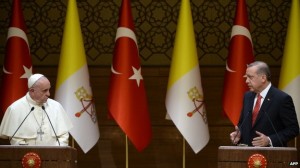 I am pleased to visit your country so rich in natural beauty and history, and filled with vestiges of ancient civilizations. It is a natural bridge between two continents and diverse cultures. This land is precious to every Christian for being the birthplace of St Paul, who founded various Christian communities here, and for hosting the first seven Councils of the Church. It is also renowned for the site near Ephesus which a venerable tradition holds to be the “Home of Mary”, the place where the Mother of Jesus lived for some years. It is now a place of devotion for innumerable pilgrims from all over the world, not only for Christians, but also for Muslims.
I am pleased to visit your country so rich in natural beauty and history, and filled with vestiges of ancient civilizations. It is a natural bridge between two continents and diverse cultures. This land is precious to every Christian for being the birthplace of St Paul, who founded various Christian communities here, and for hosting the first seven Councils of the Church. It is also renowned for the site near Ephesus which a venerable tradition holds to be the “Home of Mary”, the place where the Mother of Jesus lived for some years. It is now a place of devotion for innumerable pilgrims from all over the world, not only for Christians, but also for Muslims.
Yet, the reasons why Turkey is held with such regard and appreciation are not only linked to its past and ancient monuments, but also have to do with the vitality of its present, the hard work and generosity of its people, and its role in the concert of nations.
It brings me great joy to have this opportunity to pursue with you a dialogue of friendship, esteem and respect, in the footsteps of my predecessors Blessed Paul VI, Saint John Paul II and Benedict XVI. This dialogue was prepared for and supported by the work of the then Apostolic Delegate, Angelo Giuseppe Roncalli, who went on to become Saint John XXIII, and by the Second Vatican Council.
Today what is needed is a dialogue which can deepen the understanding and appreciation of the many things which we hold in common. Such a dialogue will allow us to reflect sensibly and serenely on our differences, and to learn from them.
There is a need to move forward patiently in the task of building a lasting peace, one founded on respect for the fundamental rights and duties rooted in the dignity of each person. In this way, we can overcome prejudices and unwarranted fears, leaving room for respect, encounter, and the release of more positive energies for the good of all.
To this end, it is essential that all citizens – Muslim, Jewish and Christian – both in the provision and practice of the law, enjoy the same rights and respect the same duties. They will then find it easier to see each other as brothers and sisters who are traveling the same path, seeking always to reject misunderstandings while promoting cooperation and concord. Freedom of religion and freedom of expression, when truly guaranteed to each person, will help friendship to flourish and thus become an eloquent sign of peace.
The Middle East, Europe and the world all await this maturing of friendship. The Middle East, in particular, has for too long been a theatre of fratricidal wars, one born of the other, as if the only possible response to war and violence must be new wars and further acts of violence.
How much longer must the Middle East suffer the consequences of this lack of peace? We must not resign ourselves to ongoing conflicts as if the situation can never change for the better! With the help of God, we can and we must renew the courage of peace! Such courage will lead to a just, patient and determined use of all available means of negotiation, and in this way achieve the concrete goals of peace and sustainable development.
Mr President, inter-religious and inter-cultural dialogue can make an important contribution to attaining this lofty and urgent goal, so that there will be an end to all forms of fundamentalism and terrorism which gravely demean the dignity of every man and woman and exploit religion.
Fanaticism and fundamentalism, as well as irrational fears which foster misunderstanding and discrimination, need to be countered by the solidarity of all believers. This solidarity must rest on the following pillars: respect for human life and for religious freedom, that is the freedom to worship and to live according to the moral teachings of one’s religion; commitment to ensuring what each person requires for a dignified life; and care for the natural environment. The peoples and the states of the Middle East stand in urgent need of such solidarity, so that they can “reverse the trend” and successfully advance a peace process, repudiating war and violence and pursuing dialogue, the rule of law, and justice.
Sadly, to date, we are still witnessing grave conflicts. In Syria and Iraq, particularly, terrorist violence shows no signs of abating. Prisoners and entire ethnic populations are experiencing the violation of the most basic humanitarian laws. Grave persecutions have taken place in the past and still continue today to the detriment of minorities, especially – though not only – Christians and Yazidis. Hundreds of thousands of persons have been forced to abandon their homes and countries in order to survive and remain faithful to their religious beliefs.
Turkey, which has generously welcomed a great number of refugees, is directly affected by this tragic situation on its borders; the international community has the moral obligation to assist Turkey in taking care of these refugees. In addition to providing much needed assistance and humanitarian aid, we cannot remain indifferent to the causes of these tragedies. In reaffirming that it is licit, while always respecting international law, to stop an unjust aggressor, I wish to reiterate, moreover, that the problem cannot be resolved solely through a military response.
What is required is a concerted commitment on the part of all, based on mutual trust, which can pave the way to lasting peace, and enable resources to be directed, not to weaponry, but to the other noble battles worthy of man: the fight against hunger and sickness, the promotion of sustainable development and the protection of creation, and the relief of the many forms of poverty and marginalization of which there is no shortage in the world today.
Turkey, by virtue of its history, geographical position and regional influence, has a great responsibility: the choices which Turkey makes and its example are especially significant and can be of considerable help in promoting an encounter of civilizations and in identifying viable paths of peace and authentic progress.
May the Most High bless and protect Turkey, and help the nation to be a strong and fervent peacemaker!
Black Friday
Christ the King
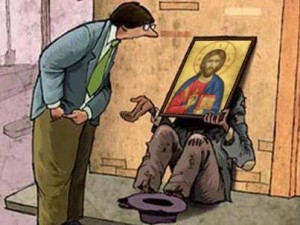 Today in the Ordinary Form of the Roman Rite is the Solemn Feast of “Christ the King” (the Extraordinary Form observed feast a month ago). I cam across this rather interesting and provocative image for the Christ the King with the question: “Christ the Least of These”? Of course, Matthew 25 is the judgement we all face.
Today in the Ordinary Form of the Roman Rite is the Solemn Feast of “Christ the King” (the Extraordinary Form observed feast a month ago). I cam across this rather interesting and provocative image for the Christ the King with the question: “Christ the Least of These”? Of course, Matthew 25 is the judgement we all face.
Some reduce the person of Jesus and His kingship with being “impressed” in favor of being “transformed.” Actually, I prefer the theological datum of being transfigured. Christ the King is reason enough to be impressed but His work as king is a service to all with a preference for the humble because He Himself was made low in the Incarnation.
What comes to mind is the pious story of St Martin of Tours with his encounter with a beggar who was none other than Jesus. What comes to mind all the ways in which we Catholics live the Faith with a similar gaze Christ had for hungry, the thirsty, the lonely, the imprisoned, the sorrowful and ignorant.
The Year of Consecrated Life
 The Year of Consecrated Life begins with the First Sunday of Advent 2014 and concludes with the World Day of Consecrated Life, 2 February 2016. The USCCB staged a media conference announcing the year’s activities in the United States. The bishops’ plans include “Days with Religious,” a series of initiatives and resources to help people learn about the consecrated life of religious men and women. Activities will focus on sharing experiences of prayer, service, and community life with those living a consecrated life.
The Year of Consecrated Life begins with the First Sunday of Advent 2014 and concludes with the World Day of Consecrated Life, 2 February 2016. The USCCB staged a media conference announcing the year’s activities in the United States. The bishops’ plans include “Days with Religious,” a series of initiatives and resources to help people learn about the consecrated life of religious men and women. Activities will focus on sharing experiences of prayer, service, and community life with those living a consecrated life.The Vatican congregation for consecrated life issued a calendar of events in Rome and the logo above. The National Religous Vocation Conference created a YCL logo and a Parish Packet, and commissioned a new hymn from Steven C. Warner. “Wake Up the World,” based on the words of Pope Francis, is available in the full score, melody, and multilingual versions. All can be found on the NRVC website.
Talent God gave you
The Gospel the Church gives us for today, the 33rd Sunday through the Church Year is a challenging one for us: it forces us to know what our personal mission is, and to discern the mission according to God’s plan. Mission, talent, personal dignity all require a degree of humility but also a holy boldness to know the gift God has given and then take that gift and be light for the world, salt for the earth…all given to build up the body of Christ, the Church.
St. John Chrysostom teaches: “Let us therefore, knowing these things, contribute whatever we have – wealth, diligence or caregiving – for our neighbor’s advantage. For the talents here are each person’s abilities, whether in the way of protection, or in money, or in teaching or in whatever thing you have been given. Let no one say ‘I have but one talent and can do nothing with it.’ You are not poorer than the widow. You are not more uninstructed than Peter and John, who were both ‘unlearned and ignorant men’. Nevertheless, since they demonstrated zeal and did all things for the common good, they were received into heaven. For nothing is so pleasing to God as to live for the common advantage.”
Dedication of the Laterna Basilica
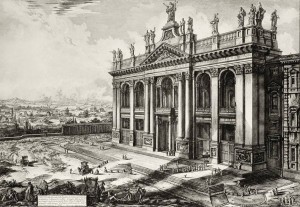 Some may wonder why the Catholic Church honors the dedication of a church in Rome today and not follow the regular course of the liturgical year. The Lateran Basilica is not your ordinary church building. It is the seat of the bishop of Rome’s pastoral authority, it the incarnation of the ministry of St Peter whom the Lord gave the keys to the Kingdom. So, the feast is not merely about a holy temple dedicated to the Lord’s service and our sanctification but also the teaching, sanctify and pastoral authority of the papal office first given to Peter which extends in time until today. It is the place of which each and every Catholic Church and Catholic receives its identity and mission: it is the place when the sacraments and the Good News rings out to the entire world because they are true.
Some may wonder why the Catholic Church honors the dedication of a church in Rome today and not follow the regular course of the liturgical year. The Lateran Basilica is not your ordinary church building. It is the seat of the bishop of Rome’s pastoral authority, it the incarnation of the ministry of St Peter whom the Lord gave the keys to the Kingdom. So, the feast is not merely about a holy temple dedicated to the Lord’s service and our sanctification but also the teaching, sanctify and pastoral authority of the papal office first given to Peter which extends in time until today. It is the place of which each and every Catholic Church and Catholic receives its identity and mission: it is the place when the sacraments and the Good News rings out to the entire world because they are true.
Hence, the Church re-proposes what she professes as the abiding and objective presence of God revealed in history in the new and indestructible Temple, which is the Body of our Lord Jesus Christ, our Savior and the ministry through the ages in the Church.
Saint Augustine teaches:
“What was done here, as these walls were rising, is reproduced when we bring together those who believe in Christ. For, by believing they are hewn out, as it were, from mountains and forests, like stones and timber; but by catechizing, baptism and instruction they are, as it were, shaped, squared and planed by the hands of the workers and artisans. Nevertheless, they do not make a house for the Lord until they are fitted together through love” (Sermon 36.)
This basilica and not Saint Peter’s is properly the Pope’s Church.
The Basilica was dedicated on this date in 324 by Pope Sylvester and holds the title of “The Church of the Most Holy Savior” but also it bears the names of Saints John the Baptist and John the Evangelist.
While not reflecting on the Dedication of the Basilica of Saint John Lateran in Rome Saint Augustine does form a few a ideas to meditate on: “‘Jerusalem that is being built as a city.’ When David was uttering these words, that city had been finished, it was not being built. It is some city he speaks of, therefore, which is now being built, unto which living stones run in faith, of whom Peter says, ‘You also, as living stones, are built up into a spiritual house, that is, the holy temple of God’. What does it mean, you are built up as living stones? You live, if you believe, but if you believe, you are made a temple of God; for the Apostle Paul says, ‘For God’s temple is holy, and you are that temple’.”
But as a little history may be important, Dom Prosper Guéranger offers a perspective on today’s feast:
The residence of the Popes which was named the Lateran Palace was built by Lateranus Palutius, whom Nero put to death to seize his goods. It was given in the year 313 by Constantine the Great to Saint Miltiades, Pope, and was inhabited by his successors until 1308, when they moved to Avignon. The Lateran Basilica built by Constantine near the palace of the same name, is the first Basilica of the West. Twelve councils, four of which were ecumenical, have assembled there, the first in 649, the last in 1512.
If for several centuries the Popes have no longer dwelt in the Palace, the primacy of the Basilica is not thereby altered; it remains the head of all churches. Saint Peter Damian wrote that just as the Saviour is the Head of the elect, the church which bears His name is the head of all the churches. Those of Saints Peter and Paul, to its left and its right, are the two arms by which this sovereign and universal Church embraces the entire earth, saving all who desire salvation, warming them, protecting them in its maternal womb.
The Divine Office narrates the dedication of the Church by the Pope of Peace, Saint Sylvester:
It was the Blessed Pope Sylvester who established the rites observed by the Roman Church for the consecration of churches and altars. From the time of the Apostles there had been certain places dedicated to God, which some called oratories, and others, churches. There, on the first day of the week, the assembly was held, and there the Christian people were accustomed to pray, to hear the Word of God, and to receive the Eucharist. But never had these places been consecrated so solemnly; nor had a fixed altar been placed there which, anointed with sacred chrism, was the symbol of Our Lord Jesus Christ, who for us is altar, victim and Pontiff. But when the Emperor Constantine through the sacrament of Baptism had obtained health of body and salvation of soul, a law was issued by him which for the first time permitted that everywhere in the world Christians might build churches. Not satisfied to establish this edict, the prince wanted to give an example and inaugurate the holy labors. Thus in his own Lateran palace, he dedicated a church to the Saviour, and founded the attached baptistry under the name of Saint John the Baptist, in the place where he himself, baptized by Saint Sylvester, had been cured of leprosy. It is this church which the Pontiff consecrated in the fifth of the ides of November; and we celebrate the commemoration on that day, when for the first time in Rome a church was thus publicly consecrated, and where a painting of the Saviour was visible on the wall before the eyes of the Roman people.
When the Lateran Church was partially ruined by fires, enemy invasions, and earthquakes, it was always rebuilt with great zeal by the Sovereign Pontiffs. In 1726, after one such restoration, Pope Benedict XIII consecrated it anew and assigned the commemoration of that event to the present day. The church was afterwards enlarged and beautified by Popes Pius IX and Leo XIII.
(L’Année liturgique (Mame et Fils: Tours, 1919), The Time after Pentecost, VI, Vol. 15. Translation O.D.M.)
All Souls
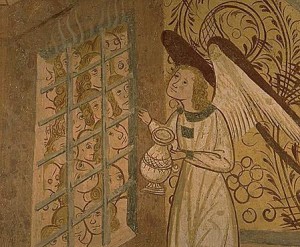 The Novus Ordo liturgy observed All Souls day yesterday; today the Extraordinary Form observed the commemoration today.
The Novus Ordo liturgy observed All Souls day yesterday; today the Extraordinary Form observed the commemoration today.
“All Souls Day focuses our attention on the process of purgation in preparation for the soul’s entrance into the presence of God. Not many experience a perfectly prepared entrance into heaven. The journey of life can be messy. A period of cleansing is not be be unexpected. The Church has called this process Purgatory. Since there is no time in eternity the period of purgation is a mystery. This image shows the loving mercy of God being ministered to the souls in Purgatory by an angel. We pray for all those who have died especially in the past year that they may soon see the Face of God.” (Dom J. King, OSB)
Eternal rest, grant unto them O Lord…
Cardinal O’Malley’s homily for Msgr Albacete: where Christ the stranger becomes Christ the friend
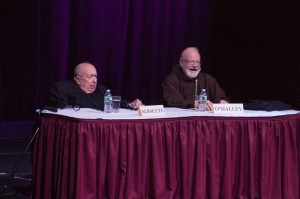 Cardinal O’Malley (of Boston) was a longtime friend of Monsignor Lorenzo Albacete. It was O’Malley who offered the Mass of Christian Burial and delivered the following homily. I laughed and cried. It is a beautiful text for learning the faith, and sharing friendship. Be prepared.
Cardinal O’Malley (of Boston) was a longtime friend of Monsignor Lorenzo Albacete. It was O’Malley who offered the Mass of Christian Burial and delivered the following homily. I laughed and cried. It is a beautiful text for learning the faith, and sharing friendship. Be prepared.
Allow me first of all to tender my heartfelt condolences to Manuel, to Mary and Olivetta, to the many friends and the C.L. (Communion and Liberation) communities.
I spoke with Cardinal Wuerl yesterday, he wanted to be here and sends regards and assurances of prayer and condolences. The Cardinal has asked Fr. Lee Fangmeyer and Fr. Frank Early to represent him and the archdiocese of Washington. Father Lorenzo was very proud to be a member of the clergy of Washington.
I also wish to express gratitude to the Parish of St. Mary’s where for many years father Lorenzo celebrated the Spanish mass. Thank you, Fr. Andrew, for your gracious hospitality.
We are also pleased that Archbishop Roberto Gonzalez, such a close friend of father Lorenzo’s, Bishop Cisneros, Fr. Jose Medina, and Fr. Chris Marino are all with us this morning. We are especially pleased that the supreme Knight Carl Anderson and his dear wife Dorian are here as well.
“Harto dificil resulta para mi…”
These were the opening words of my homily at Lorenzo’s first Mass. they became sort of a code that I would throw into a talk if Lorenzo were present. That would always get a rise out of him.
But today these words ring true: Harto dificil resulta para mi.
This is very hard for all of us who love this man.
Graham Greene, Evelyn Waugh and Garcia Marquez together did not have enough imagination and genius to invent Father Lorenzo Albacete Cintrón. Only God could create a Lorenzo and then He broke the mold because the world did not deserve to have two Lorenzo’s.
In the English world, the day after Christmas is boxing day, a day when employees and tradesmen would receive gifts. If Puerto Rico had a boxing day it would be the day after the feast of the Epiphany or” Reyes” as the Boricuas say; it would be January 7. That is the day Lorenzo arrived in this world. He has truly been a gift, a gift of the Magi to borrow the title from O’Henry’s story, but Lorenzo is the gift of the Magi, the Reyes.
He has certainly been a gift in my life for almost 5 decades. I had met Lorenzo at that time in his life when he took his famous vacation to Bogota, Colombia. A vacation Manolo arranged for Lolo (for Lorenzo). Later Lorenzo told us how he disguised himself as a priest to get near Pope Paul. When he confessed to the Pope he was not really a priest, Blessed Pope Paul said: “Why don’t you become a priest?
It was also around that time when Lorenzo first met Cardinal O’Boyle the Archbishop of Washington. Lorenzo and I spent a lot of time at St. Matthews Cathedral where I was working with Rosario Corredera and the Hispanic community. Lorenzo used to drive me very often. One day, as he was wont to do, Lorenzo parked in the Cardinal’s parking space… (Any ‘no parking’ sign was an invitation to Lorenzo.) At that moment Cardinal O’Boyle was approaching and confronted Lorenzo: “who are you,” he asked. Lorenzo replied: “I am the Cardinal”. Cardinal O’Boyle, who was something of a curmudgeon, answered back: “I am the Cardinal!” To which Lorenzo said: “yes, you are the day Cardinal; I am the night Cardinal.”
It is no wonder that after his first Mass, Lorenzo’s mother asked me to bless her new apartment. I said, “But, doña Conchita, your son was just ordained.” She said, “Yes, padre, but I think he is joking.”
Sometimes Lorenzo ruffled the feathers of the hierarchy.
Cardinal Hickey installed a special phone with an answering machine for priests so that a priest could call it any time if he had a problem. Lorenzo used to call and say things like: “your Eminence, I’ve lost my car keys, could you help me find them.” After the Cardinal was convinced that Lorenzo was not a mental case, he made him his theological advisor.
When Lorenzo was working in Boston, he brought a car phone. Only the president of the Unites States, the chief of police and the head of the mafia had a car phones in those days. When Lorenzo had a car phone installed, I chided him for his extravagance and warned him that the auxiliary Bishop was very critical of Lorenzo’s spending habits. So Lorenzo said: “really? Let’s call him up.” So Lorenzo called the Bishop from his phone in the car and said: “I’m out for a ride with Bishop Sean and I’m calling you on my new car phone. Whoops. I have to hang up, my other car phone is ringing now.” Likewise in Boston when Lorenzo was asked to preach one of the Seven Last Words for the Good Friday services at the Cathedral of the Holy Cross, Lorenzo said: “which of the seven last words Am I supposed to speak on?” When he was told that he should preach on: “my God, my God, why have you forsaken me?” Lorenzo replied: “good, I won’t have to prepare.”
And when he was installed as the Rector Magnifico of the Pontifical Catholic University of Puerto Rico, he was standing next to me on the stage. Lorenzo was wearing a baby blue academic gown with royal blue velvet panels in the ample sleeves, a colorful hood on his back, and a velvet bonnet with a golden tassel. He was carrying something that looked like a wand. Lorenzo turned to me and said: “If this gig as president doesn’t work out, I could get a job with Walter Mercado, (who is a very flamboyant Puerto Rican psychic and astrologer with a Liberaci-sque wardrobe.)
Lorenzo’s friendship with John Paul II dates to when the then Cardinal Wojtyla visited Washington. Cardinal Baum asked Lorenzo to drive the future Pope around. After he returned to Poland Cardinal Wojtyla wrote to Lorenzo with comments and ideas on the research Lorenzo was involved in at the time. A few years later John Paul II returned to Washington. When he met Lorenzo at St. Matthews he said: “Lorenzo, maybe now you will answer my letters.”
Years later Lorenzo was called to Rome to present plans for the John Paul II Institute along with a father from Opus Dei. The priest from Opus Dei was impeccably dressed in his cassock, well groomed for the occasion. He had his copious and well-developed notes in a beautiful leather binder. The priest began by saying: “your Holiness, I did not sleep at all last night knowing that today I would have to make this presentation to the Vicar of Christ on earth.” He then made a very formal and thorough presentation of his well-developed ideas. Afterwards Pope John Paul turned to Lorenzo and asked him to make his presentation. Lorenzo, with a menu of two weeks on his clerical shirt, began by saying: “your Holiness, Your Holiness, I slept very well last night.” Lorenzo then produced an envelope from Riggs Bank, from his suit coat pocket and declared: “I had an overdraft in my checking account, so the bank notified me and sent me this envelope.” He then read his brilliant notes from the back of the envelope and thoroughly entertained St. John Paul II.
We must be careful not to be so dazzled by Lorenzo’s incredible sense of humor. (Fue el hombre más occurente que había conocido en toda mi vida). There was so much more to Lorenzo. What was so out there were: his zany wit, his unkept appearance, his disorganized life, his financial problems, his phobias and his eccentricities. But as Erasmus said of Thomas More: “He was made and born for friendship.” What a capacity for unconditional love! He made everyone feel at home, you knew that you were with a friend. “En el crepusculo de la vida, seremos juzgados solo por el amor,” said San Juan de la Cruz. “At the end of our life we will be judged only by how much we loved.”
Lorenzo’s love for his family, for Conchita, for Manolo, and for friends on every continent, Catholics and atheists, Jews and Protestants was unfailing Lorenzo’s love touched everybody, whether they were from Triumph Magazine to the New Republic. He had what the Spanish call “don de gente.”
That capacity for love, compassion, empathy, made Lorenzo a great friend and a great priest, because the goodness of the Good Shepherd could be glimpsed in his goodness.
Lorenzo’s was not an easy life and his problems were a great source of worry to those of us who were close to him. There were so many false starts. Lorenzo’s meteoric career as President of the Universidad Católica in Ponce. After Lorenzo lost his job as Rector, I sent him two quotes from Fray Luis de León:
“Que descansada vida
la del que huye del mundanal ruido
y sigue la escondida senda
por donde han ido
los pocos sabios que en el mundo han sido.”
After experiencing what envy and intrigue can do to you, Lorenzo was like Fray Luis who wrote:
“Y con pobre mesa y casa
en el campo deleitoso
con solo Dios se compasa
y a solas su vida pasa
ni envidiado ni envidioso.”
Lorenzo’s tenure at Dunwoody was cut short; and his writing for the Sunday Magazine of New York Times came to naught.
But all of the pain and disappointment was dissipated because of Lorenzo’s friendship with Don Giussani. Communion and Liberation was a God send for Lorenzo. And I believe that Lorenzo was a God send for C.L. God’s loving providence engineered this wonderful match. Lorenzo loved young people and was such a gifted teacher and mentor to them. His genius was to be able to dialogue with the culture, science, and with the media. His intellect was so bright and still more illumined by his deep faith.
The love and devotion of the C.L. Community, Olivetta Danese and so many who really cared for Lorenzo and allowed him to accomplish so much, to blossom. All of the wonderful articles inTracce and other publications, the retreats and conferences would never have happened without the help and support of CL. Lorenzo dedicated his book God at the Ritz to Don Giussani from whom Lorenzo learned so much. Lorenzo defines suffering as a thirst for meaning, for understanding, for solidarity, for friendship, for affirmation. Lorenzo said: “The one who suffers wants to be assured that he or she is not crazy, guilty, an outcast for life. I have tried to show how suffering can be a point of departure towards an encounter with Mercy as the origin and destiny of life.”
Today we are consoled that Lorenzo’s suffering was that point of departure, a preface to an encounter with Mercy.
The Emmaus story documents the encounter of two disciples, overcome with grief and fear, and the Risen Christ who seeks them out like the Hound of Heaven. It is the story of a journey and an encounter, two concepts dear to Don Giussani and Lorenzo. It is the story of pain and loss, being transformed into new life and joy. The disciples are running from Calvary, they are seeking safety and they find Christ. Or Christ finds them.
They engage in a conversation. Cor ad cor loquitur. Their hearts are burning within them. Lorenzo engaged in so many of those conversations that allowed people to discover the reality of Christ. Lorenzo’s journey touched the lives of many fellow travelers and allowed them to experience Christ no longer as a stranger, but as a friend.In his own brokenness, Lorenzo could break open the word of God and release its power.
To me, one of the most fascinating lines in this Gospel is where Luke records that Jesus “gave the impression that He was going on farther.” At that moment the disciples might have said: “great talking to you. So long. See you around.” This Gospel would never have been written if they had not invited Jesus to stay with them. Christ wants to be invited. At supper, Jesus shares with them His identity and allows them to recognize Him in His self giving in the breaking of the bread. In St. Matthew’s Cathedral the De Rosen mosaic behind the altar of the Blessed Sacrament depicts the two disciples filled with Eucharistic amazement and the inscription declares: “they recognized Him in the breaking of the bread.” The Lord disappears, but the bread remains, now in the tabernacle, the Body and Blood of Christ.
They set out at once and returned to Jerusalem. They were now willing to risk their lives to share the Good News. They become participants of the mission of their Master to bring glad tidings, to liberate those captive by fear in the Cenacle, to place on those who mourn in Zion a diadem instead of ashes.
I like to think that Cleopas and his buddy were at the Cenacle with Mary and the Apostles for the outpouring of the Spirit on the Church. And I see them in today’s second reading from Acts, part of that community, devoted to the teaching of the Apostles, holding all their material goods in common, caring for the needs of all, and most importantly gathering in their homes for the breaking of the bread. Discipleship really is about liberation and communion. And the joy of knowing that the Lord added to their numbers those who were being saved.
Lorenzo’s journey was an Emmaus journey where Christ the stranger becomes Christ the friend and liberator. Lorenzo was an eloquent messenger of the joy of the Gospel. He found his strength in the Eucharist, he recognized Jesus in the breaking of the Bread.
Let me conclude with the prayer of an old priest, painfully aware of his own limitations and brokenness who reflects that when he lifts the host, he is overwhelmed by his own unworthiness, and he pleads with God that just as the priest held God in his unworthy hands, that God will never let him slip from God’s divine hands.
PLEGARIA DE UN SACERDOTE
(Lope de Vega)
Cuando en mis manos, Rey eterno, os miro
y la cándida víctima levanto,
de mi atrevida indignidad me espanto
y la piedad de vuestro pecho admiro.
Tal vez el alma con temor retiro,
tal vez la doy al amoroso llanto,
que, arrepentido de ofenderos tanto,
con ansias temo y con dolor suspiro.
Volved los ojos a mirarme humanos,
que por las sendas de mi error siniestras
me despeñaron pensamientos vanos;
no sean tantas las desdichas nuestras
que a quien os tuvo en sus indignas manos
vos le dejeis de las divinas vuestras.
Heavenly Father,
In thy hands we commend our brother, Lorenzo.
Hold on tight.
Seán Patrick Cardinal O’Malley
Archbishop of Boston
Homily Monsignor Albacete Funeral Mass
St. Mary’s Church, Manhattan
October 28, 2014
